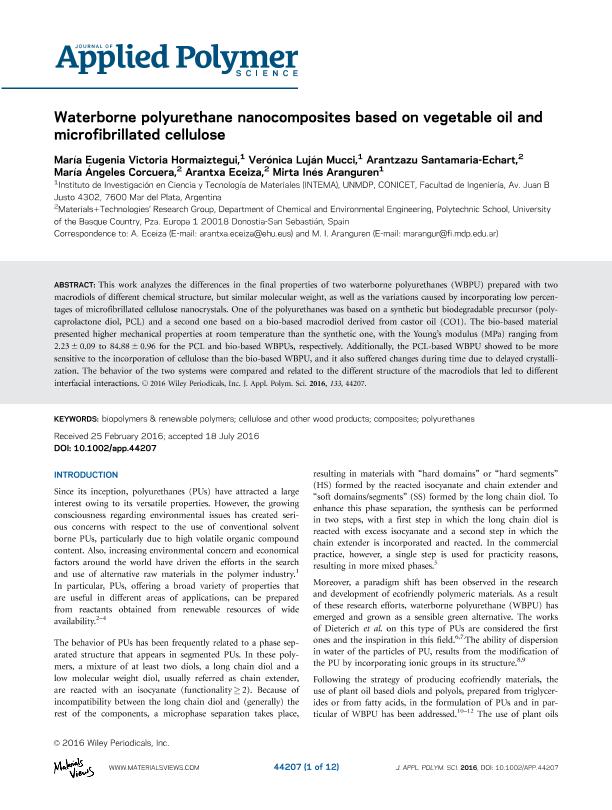Artículo
Waterborne polyurethane nanocomposites based on vegetable oil and microfibrillated cellulose
Hormaiztegui, Maria Eugenia Victoria ; Mucci, Veronica Lujan
; Mucci, Veronica Lujan ; Santamaria Echart, Arantzazu; Corcuera, María Angeles; Eceiza, Arantxa; Aranguren, Mirta Ines
; Santamaria Echart, Arantzazu; Corcuera, María Angeles; Eceiza, Arantxa; Aranguren, Mirta Ines
 ; Mucci, Veronica Lujan
; Mucci, Veronica Lujan ; Santamaria Echart, Arantzazu; Corcuera, María Angeles; Eceiza, Arantxa; Aranguren, Mirta Ines
; Santamaria Echart, Arantzazu; Corcuera, María Angeles; Eceiza, Arantxa; Aranguren, Mirta Ines
Fecha de publicación:
06/09/2016
Editorial:
John Wiley & Sons Inc
Revista:
Journal of Applied Polymer Science
ISSN:
0021-8995
Idioma:
Inglés
Tipo de recurso:
Artículo publicado
Clasificación temática:
Resumen
This work analyzes the differences in the final properties of two waterborne polyurethanes (WBPU) prepared with twomacrodiols of different chemical structure, but similar molecular weight, as well as the variations caused by incorporating low percentagesof microfibrillated cellulose nanocrystals. One of the polyurethanes was based on a synthetic but biodegradable precursor (polycaprolactonediol, PCL) and a second one based on a bio-based macrodiol derived from castor oil (CO1). The bio-based materialpresented higher mechanical properties at room temperature than the synthetic one, with the Young?s modulus (MPa) ranging from2.2360.09 to 84.8860.96 for the PCL and bio-based WBPUs, respectively. Additionally, the PCL-based WBPU showed to be moresensitive to the incorporation of cellulose than the bio-based WBPU, and it also suffered changes during time due to delayed crystallization.The behavior of the two systems were compared and related to the different structure of the macrodiols that led to differentinterfacial interactions.
Archivos asociados
Licencia
Identificadores
Colecciones
Articulos(INTEMA)
Articulos de INST.DE INV.EN CIENCIA Y TECNOL.MATERIALES (I)
Articulos de INST.DE INV.EN CIENCIA Y TECNOL.MATERIALES (I)
Citación
Hormaiztegui, Maria Eugenia Victoria; Mucci, Veronica Lujan; Santamaria Echart, Arantzazu; Corcuera, María Angeles; Eceiza, Arantxa; et al.; Waterborne polyurethane nanocomposites based on vegetable oil and microfibrillated cellulose; John Wiley & Sons Inc; Journal of Applied Polymer Science; 133; 47; 6-9-2016; 44027
Compartir
Altmétricas



